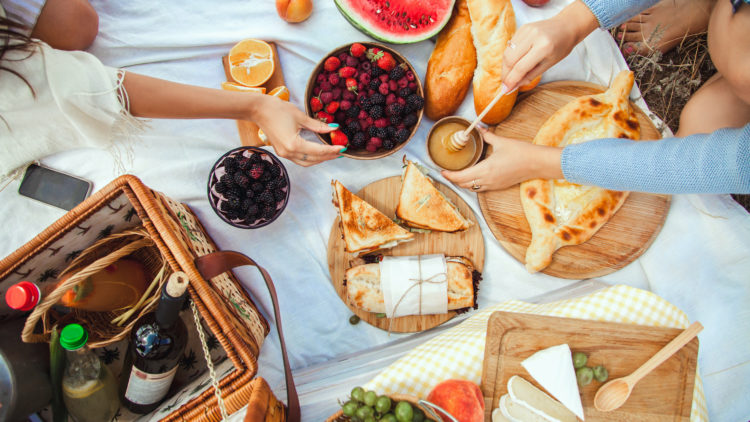
The sun is finally coming out. As W. Somerset Maugham’s said, ‘there are few things so pleasant as a picnic lunch’.What nicer way to meet up with friends and family?
Picnic nostalgia
My childhood memories of a 70s picnic are an over-heating car, scratchy rug, sausage rolls, soggy tomato sarnies, Golden Wonder crisps and a flask of warm tea. I hope my Mum doesn’t read this! Things have fortunately, in the picnic world, moved on, for the better. But it got me thinking about the origins of a picnic and what makes a great picnic?
Picnic history
According to the BBC, picnic was a 17th Century French word, ‘picque-nique’. Its meaning was similar to today: a social gathering where each attendee brings a share of the food. The term picnic does not appear in the English language until the mid 1700s. The OED says picnic was mentioned in a letter written by Lord Chesterfield in 1748. It seems the french brought the picnic tradition here with them, after fleeing the revolution. At that time, it was an indoor affair, very luxurious and decadent, including entertainment.
Picnic paintings
In my research I discovered picnics are depicted in many paintings. It seems a more decadent approach to the alfresco dining was popular in the past! So today, our views on how to have a picnic seem to stem from the early 1800s. Even Jane Austen got in on the act in 1816 with a rustic picnic on Box Hill.
Picnic royalty
Mrs. Beeton, whose ‘Book of Household Management’ was published in 1859 lists ingredients for a picnic lunch including; collared calf’s head, roast fowls, stewed fruit well sweetened, cold plum-pudding, blancmanges in moulds, plum, pound and sponge cakes, mixed biscuits, bottles of ale, sherry and claret, champagne à discrétion, 1/2 lb, of tea. She stated that coffee was not suitable for a picnic, being difficult to make (sorry no Perkee coffee at Mrs Beeton’s picnic!).
She also lists things not to be forgotten at a Picnic lunch; a stick of horseradish, a bottle of mint-sauce, well corked, a bottle of salad dressing, a bottle of vinegar, made mustard, pepper, salt, good oil, and pounded sugar.
This list shows that travelling light would not be possible with Mrs Beeton’s picnic. But it wasn’t long until it changed. In the later 1800s picnics were adopted by the aspirational and middle classes and moved outdoors. They became a more accessible affair – particularly as public transport improved and people bought cars.
Picnic favourites
In the last year picnics have enjoyed a renaissance. They have proved to be a great way for friends and family to meet up safely. Even though sushi, hummus and quinoa are making an appearance, it seems traditional foods remain the favourites. In National Picnic week, a survey by a national baker revealed the nation’s top ten favourite savoury picnic foods. Crisps topped the list, followed by sandwiches, sausages rolls, cherry tomatoes, rolls/baps, pork pies, Scotch eggs, slices of cheese, cocktail sausages and hard-boiled eggs.
Ingredients for a great picnic
What makes a great picnic? First of all- it’s the company. Making some memories.
Picnic food
A picnic is a collaboration, it’s exciting to see what other people bring. As a child, I always loved that our friends, the Clarkes, brought ready-made custard. It seemed so luxurious. We used to meet up in Windsor Great park, 3 families of 10 children, played games and finished off with cold apple pie and custard shared amongst us- yum.
Foods whose taste doesn’t rely on being cold are best, like hard cheeses. And remember to use beeswax wrap to keep everything fresh. Keep wet stuff out of bread so that it avoids becoming soggy. Pete Redman recommends using an insulation layer. Layer a lettuce leaf or slice of cheese to stop the liquid ingredients soaking into the bread.
Picnic drinks
A nice Rose wine (I like M&S Vinho Verde at £7 a bottle) and some cold beers or some refreshing fruit coolers are all ideal for a picnic. Try our Hibiscus lemonade of Elderflower punch recipes.
Picnic gear
In the UK, it’s always best to prepare for all eventualities, so sun-cream, jumpers, waterproofs, rugs (non-scratchy preferred) and umbrellas are essential.
Picnic dos and don’ts
Picnics can generate a lot of waste with most of it ending up in landfill. Don’t leave litter in our parks, beaches and countryside to harm our environment and wildlife. Remember to leave no trace- separate your recyclables and take all your rubbish home with you.
And don’t forget the corkscrew or bottle opener!
If you want inspiration for practical picnic ideas do use Pete Redman, our chef director’s delicious recipes.
Share on:
Marketing Director
More from Lin Dickens